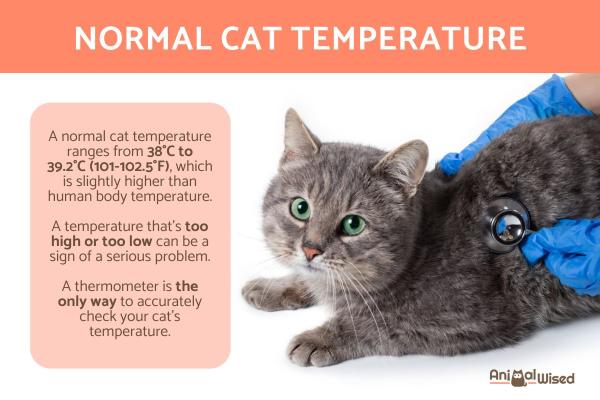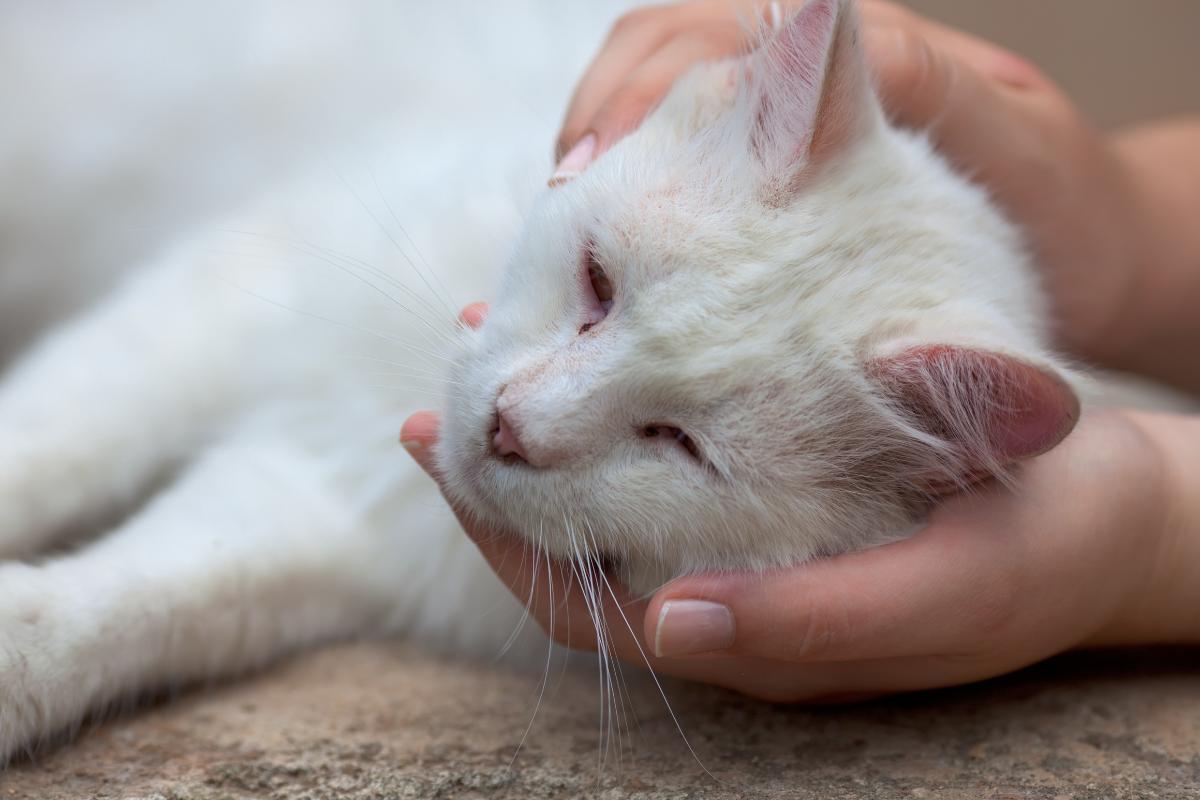What Is a Normal Cat Temperature?



See files for Cats
Keeping an eye on your cat's health means knowing what's normal, and that includes their temperature. While it's a common belief that you can tell if a cat's running a fever just by touching their nose or ears, the truth is, a thermometer is the only way to get an accurate reading. A temperature that's too high or too low can be a sign of a serious problem. Whether it's a fever (hyperthermia) or a dangerously low temperature (hypothermia), any reading outside the normal range means it's time to talk to your vet.
This AnimalWised article explains normal cat temperatures, the factors that can affect them, and what it means if your cat's temperature is too high or too low.
What is a normal kitten temperature?
A kitten's normal body temperature should be between 101-102.5°F (38.3-39.2°C). This is slightly higher than the normal human body temperature. If a kitten's temperature falls outside this range, either higher or lower, it could indicate a health issue that requires veterinary attention.
Young kittens, typically those under 3-4 weeks old, haven't yet developed the ability to regulate their own body temperature effectively.
This is called thermoregulation, and it happens because their nervous systems are not fully developed, they have very little body fat for insulation, their fur coat isn't thick enough yet to retain heat, and their shivering response, which helps generate heat, is not fully developed.
In nature, kittens rely on their mother's body heat and the warmth of their littermates when cuddling together. For orphaned or separated kittens, they need human help to stay warm through external heat sources. These can include heating pads specifically designed for pets, warm hot water bottles wrapped in towels, special incubators for very young kittens, and soft blankets and nesting materials.
The ideal environmental temperature for newborn kittens should be around 85-90°F (29-32°C) in their immediate surroundings. As they grow older, this temperature requirement gradually decreases until they develop their own temperature regulation abilities around 4 weeks of age.
It's crucial to always provide a way for kittens to move away from the heat source if they become too warm, preventing overheating. Also, the heat source should never be directly against their skin, always use a barrier like a blanket or towel.
What is a cat’s normal temperature?
A cat's normal body temperature ranges from 101-102.5°F (38-39.2°C). Temperatures outside this range often indicate a medical issue that requires veterinary attention.
While some people believe a cat's nose temperature can indicate fever, this is a myth. A warm or dry nose can occur for many normal reasons and isn't a reliable indicator of illness. The only accurate way to measure a cat's temperature is rectally using a proper thermometer.
However, taking a cat's temperature can be stressful and potentially dangerous if done incorrectly. Unless you've been trained by a veterinarian, it's safer to have a professional check your cat's temperature as part of a complete examination, especially if you notice concerning symptoms like:
- Significant changes in eating or drinking habits.
- Unusual lethargy or behavior changes.
- Shivering or feeling unusually warm to the touch.
Remember that regular veterinary check-ups are the best way to monitor your cat's overall health, including any temperature concerns. Monitoring your cat's temperature can be tricky, but it's an important skill. Discover the proper technique and essential tips in our guide.
Why is my cat's temperature higher than normal?
We have established the normal temperature range for a cat. But what happens when a cat's temperature falls outside of that range? As previously mentioned, a temperature above or below the normal range of 38 to 39.2 degrees Celsius (100.4 to 102.6 degrees Fahrenheit) can be indicative of illness.
A cat's temperature above 39.2°C (102.5°F) can indicate either fever (pyrexia) or hyperthermia. These are two distinct conditions with different causes.
Fever occurs when the body deliberately raises its temperature to fight infection, while hyperthermia happens when external factors prevent normal temperature regulation.
Fever commonly indicates underlying infections or inflammatory conditions. A feverish cat may show symptoms like:
- Reduced appetite
- Lethargy
- Dehydration
- Other symptoms specific to the underlying condition
Hyperthermia, most commonly seen in heat stroke, occurs when cats are exposed to excessive environmental heat or cannot cool themselves properly. Cats normally cool themselves primarily through grooming (the saliva evaporating from their fur helps cool them) and by finding cool spots to rest. Unlike dogs, they don't pant much unless they're severely overheated. When these cooling mechanisms get overwhelmed, that's when hyperthermia develops.
Early signs of heat stroke include excessive panting, drooling, bright red gums, vomiting, and lethargy. As it progresses, cats may become disoriented or collapse. Their body temperature can rise to dangerous levels (above 41°C/106°F), potentially causing organ failure if not treated quickly.
Other things that can raise your cat's temperature include stress, vigorous exercise, or being in a too-warm environment. Sometimes hormonal conditions can affect temperature regulation too.
If you notice your cat's temperature is high, they need to see a vet. High body temperature can quickly become dangerous, affecting multiple organs and leading to serious complications if not addressed promptly.
While waiting to get to the vet, you can help your cat stay comfortable by making sure they're in a quiet, room-temperature space with access to water, but don't try to cool them down drastically as this could cause additional problems.
Wondering what to do if your cat's temperature rises above normal? Discover the signs, causes, and treatments in our comprehensive guide about feline fever.

Why is my cat's temperature lower than normal?
While high temperatures are often a cause for concern, it's equally important to recognize that a temperature below normal can also pose a significant health risk. Let us take a look at some of the most common reasons for low temperatures in cats:
- Often, it's related to an underlying medical condition. This could be anything from shock after an injury to a serious infection or metabolic disorder.
- Sometimes medications can be the culprit too, especially if your cat has recently had surgery and was under anesthesia.
- The environment plays a huge role as well. Your cat might have gotten caught in bad weather, fallen into water, or perhaps been trapped somewhere cold like a garage or basement. These situations can quickly lead to dangerous drops in body temperature, especially if their fur got wet in the process.
- Age can be a critical factor here too. We mentioned the fact that cats can't regulate their own temperature when they are very young. However, on the flip side, elderly cats often struggle with temperature regulation as they age.
- Severely underweight cats often struggle to maintain normal body temperature due to lack of insulation, and cats with poor circulation or those recovering from surgery are also at higher risk.
This is a serious condition requiring immediate veterinary attention. While you're preparing for the trip, wrap them in warm blankets (fresh from the dryer is perfect), but don't use heating pads as they can actually cause burns. Did you know that low body temperature can be just as dangerous as fever in cats? Discover what to watch for and when to seek help in our other article about feline hypothermia.
If you want to read similar articles to What Is a Normal Cat Temperature?, we recommend you visit our Basic care category.






